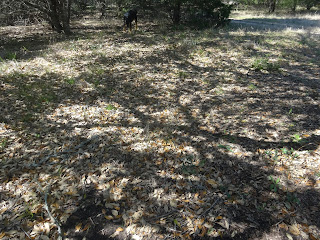In the past, we used untreated lumber to build our raised beds, but the TX sun is harsh and we were lucky to get 2 years out of them, so we decided to use cinder blocks this go round. I don't think we will be replacing them anytime soon.
Step 1: I order a bunch of stuff from Amazon and collect the boxes. This is the fun part. I remove any packaging tape on the boxes, because in previous gardens I was finding the tape in the beds years later. I am a wee bit anti-plastic anyway, so it is just easier to get rid of it from the get go.
Step 2: Put the cardboard on the ground and line up the cinder blocks to form the bed. I don't want the bed to be any wider than 30" for ease of reaching the plants from each side. Cinder blocks are heavy, by the way, and you need to wear gloves if you want any skin left on your hands.
Step 3: Fill the bed with donkey poop. It is my hottest compost and probably the longest to break down before I can use it safely without burning the new plants, so I put it on the bottom. With the donkey poop is old grass, leaves, dirt and whatever else I end up raking up as I am cleaning their pen. Luckily male donkeys poop in a few piles and just add to them as they feel the need, so it isn't really a big deal to clean up after them.
Step 4: Top the poop with carbon. We have fires to burn dead trees when the weather allows and after the fire has burnt down and cooled, we are left with black char-wood referred to as Terra Preta. Terra Preta, meaning "Black Earth" in Portuguese, is a soil building technique developed by ancient Amazonian civilizations at least 7000 years ago as a solution to permanently solve the problems of poor tropical soil fertility. Large deposits of this black earth are still found today with depths of up to 2 meters.
We have yet to figure out exactly how ancient civilizations produced Terra Preta, but what we do know is that the soils contain high amounts of char-wood (also referred to as bio-char). Char-wood is basically a form of charcoal produced by burning wood.
Char-wood, like charcoal, is a carbon source that has extreme stability in soil. In addition, it is extremely porous and therefore offers a large surface area for the formation of stable and long lasting chemical bonding of soil organic matter with soil minerals. Terra Preta soils have been found to contain organic matter content that are 50x greater and contain 3x more Phosphorus and Nitrogen as neighboring forest soils. In addition, even the heavy tropical rains do not leach nutrients out of this soil. ( http://permaculturenews.org/2010/05/25/back-to-the-future-terra-preta-%E2%80%93-ancient-carbon-farming-system-for-earth-healing-in-the-21st-century/)
So I add char-wood / carbon to my soil. It can't hurt. :)
Step 5: Add household compost. I have a little compost bucket in my kitchen and anytime I have used coffee grounds, banana peels, orange peels, used tea bags, apple cores, dog hair, etc., I throw it in the bucket. No meat allowed. When it becomes full, I add it to my compost pile or in this case, I just throw it in the garden. Yummmmm.
Step 6: Rabbit poop. I have had rabbits for years and years, primarily for the poop the little machines dole out. It is not "hot" and can be used directly in your garden. They are an inexpensive animal to keep, quiet and love weeds. Another plus. My 2 girls are best buddies, but put them together as babies, adults aren't very tolerant of new comers as a rule.
Step 7: Rake some leaves! We have a LOT of leaves and in this instance, I targeted a live oak who had quite the little leaf party going on under it's branches.
Step 8: Top Soil is layered thinly on "top". I buy the cheapest soil I can find and sprinkle it on and then the bed is put to bed until it is ready for me to plant in it. Sometimes volunteer plants grow from my kitchen compost and I let them be. Who am I to scoff at free food?
Here is the product of my hard work. I am tempted to plant herbs or flowers in the holes of the cinder blocks. I have not done this yet, but might.
So there you have it. The Pam Watkins method of starting a garden from scratch. Enjoy!












